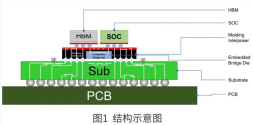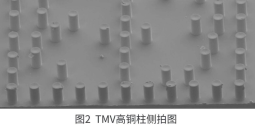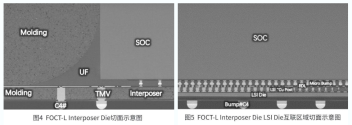agreed. some of it is probably just for show and especially since US-China talks are nearing, but after a certain point you start to realize that actually there is real confidence behind their actions, which means development and self sufficiency beyond what is formally acknowledged.For the government to be laying it down thick like this I assume they already know there are replacements for all the imports already.
You are using an out of date browser. It may not display this or other websites correctly.
You should upgrade or use an alternative browser.
You should upgrade or use an alternative browser.
Chinese semiconductor thread II
- Thread starter vincent
- Start date
That what I was thinking, they waited until their semiconductor supply chain was complete enough to bring the hammer down.For the government to be laying it down thick like this I assume they already know there are replacements for all the imports already.
Xinde Semiconductor's 2.5D packaging breakthrough! FOCT-L embedded silicon bridge adapter advanced packaging technology platform
The Xinde Semiconductor engineering team successfully completed the full-process technical verification of FOCT-L (FANOUT Connected Tech-Local Silicon Interconnect), a buried bridge fan-out high-performance chip interconnect packaging process. This marks a milestone breakthrough in the field of 2.5D/3D advanced packaging, and Xinde Semiconductor has achieved world-leading localized silicon interposer interconnect integration capabilities, officially joining the first echelon of global advanced packaging technology, and can provide core packaging support for the next generation of high-performance computing chips.

2.5D packaging core technology breakthrough FOCT-L
With the explosive growth in computing power demand, Moore's Law is gradually slowing, and advanced packaging technology is becoming a key path to continued chip performance improvement. FOCT-L packaging, the crown jewel of 2.5D/3D advanced integration technologies, boasts high density, high bandwidth, and low power consumption. It is the cornerstone supporting AI training chips, high-end GPUs, HPC processors, and large-capacity storage chips. The Xinde Semiconductor R&D team faced challenges such as local silicon bridge interconnects, high-precision bonding, ultra-thin chip stacking, and signal integrity control, successfully overcoming core technical barriers.
The R&D team has achieved high-density direct interconnection in local areas within multi-chip modules, abandoning the traditional interposer global wiring mode. By using micron-level silicon bridges (Si-Bridges) to build micron-level interconnect channels in key areas at the edge of the chip, the interconnection density is increased by more than 5 times compared to traditional packaging, and the signal transmission distance is shortened to the millimeter level. The local silicon bridge (LSI) array replaces the monolithic silicon interposer to achieve a "break the whole into parts" modular design: a single interposer integrates 2*LSI chips, supports an ultra-large packaging area of 2500mm², and the through-molded via (TMV) insertion loss is less than 0.3dB/mm, solving the problem of lithography splicing errors and removing packaging barriers for domestically produced ultra-high computing power chips.

Technological advantages
Advantage 1: Compared with the full-size silicon interposer, the silicon material area used in the local silicon bridge is reduced by more than 70%, greatly reducing the expensive silicon material cost and interposer manufacturing/processing costs, making this cutting-edge technology more economical and market competitive.

Advantage 2: This structure allows for the flexible placement of multiple local silicon bridge interconnects on the same interposer, supporting heterogeneous integration of multiple chips. Designers can freely combine chips with different process technologies and functions (such as CPU, GPU, HBM, I/O, SoC, etc.) like building blocks to achieve optimal system performance.

Advantage 3: Achieve 800nm/800nm ultra-fine line width/spacing for silicon bridge interconnection, 36μm chip bonding uBump bonding pitch, and ±1μm interlayer alignment accuracy, meeting the interconnection requirements of high-performance GPUs and reducing signal latency by 80%.
Advantage 4: The R&D team relies on a multi-physics field high-precision thermal-mechanical collaborative simulation platform to optimize the design: accurately predicting the stress distribution of the product throughout its life cycle, guiding the multi-dimensional collaborative design of silicon bridge shape, bottom filler formulation, etc., reducing the stress at key interconnection points by more than 40%; and also developing exclusive materials and matching thicknesses for the silicon bridge structure to ensure the long-term reliability of the product in harsh environments.
The successful production of the 2.5D FOCT-L sample is a strong testament to Xinde Semiconductor's technological R&D capabilities, and an important step for China's high-end semiconductor packaging industry to move towards a new stage of independent control.
TCL Technology Completes Acquisition of Equity in LGD's Chinese Subsidiary
On October 9, TCL Technology (000100.SZ) issued an announcement stating that the company completed the acquisition of 80% of the equity of LG Display (China) Co., Ltd. and 100% of the equity of LG Display (Guangzhou) Co., Ltd. held by LG Display Co., Ltd. and its affiliates through its controlling subsidiary TCL Huaxing Optoelectronics Technology Co., Ltd.
The announcement indicates that the equity acquisition has been fully completed. Upon completion of the transaction, TCL Huaxing will officially hold controlling stakes in LG Display's two major subsidiaries in China. The successful completion of this transaction marks a key step in TCL Technology's integration and layout in the global display panel industry chain.
TCL Technology stated that this acquisition will help the company further enhance its production capacity and technological capabilities in high-end display panels and strengthen its collaboration with leading global display companies. By integrating LG Display's R&D, manufacturing, and sales resources in China, the company will achieve synergies in new display technologies and the industry ecosystem.
Industry analysts believe that LG Display's sale of its Chinese assets is part of a restructuring of the global display industry, and that TCL Technology's acquisition will allow it to further strengthen its market influence in OLED and LCD technology. This will help TCL gain a larger share of the global display supply chain.
In recent years, TCL Huaxing has continued to make significant strides in high-end display panels, Mini LEDs, and flexible OLEDs. The completion of this acquisition not only consolidates TCL Technology's leading position in the mid-to-high-end panel market, but also lays a more solid foundation for the company's future international development.
That what I was thinking, they waited until their semiconductor supply chain was complete enough to bring the hammer down.
I am hearing a lot of American policy folks talking about denying all chips <=14nm to China, as well as all semiconductor equipment.
Will China be impacted by this?
At least from numbers, China buys a LOT of semi equipment, and chips <=14nm. Does China have replacement for all of them?
Ydah , i think that will be a big issue for China. Afterall, they still import alot semi conductor equipment from US allies in europe, Taiwan, Japan and south Korea. China still needs a couple of years for her semi industry to fully mature and be self sufficient. That's why im not sure why the government has taken those strong steps of restrictions on rare earth metals this time, when the country still needs semiconductor equipments and products from abroad.I am hearing a lot of American policy folks talking about denying all chips <=14nm to China, as well as all semiconductor equipment.
Will China be impacted by this?
At least from numbers, China buys a LOT of semi equipment, and chips <=14nm. Does China have replacement for all of them?
I have been reading about banning all tools for processing 300mm wafers for everyone including HuaHong. I don't think Japan and Europe will be happy with this. Also If the US can apply the FDPR, China can do it to the US. Given that ASML use Chinese materials in their machines.I am hearing a lot of American policy folks talking about denying all chips <=14nm to China, as well as all semiconductor equipment.
From I have been seeing. Yes. They already have replacement for every single tool for 14nm and less, that also includes the components and materials to make the machines. In Lithography according to government documents seems immersion lithography reached 14nm this year and EUV is closer than most people thinkWill China be impacted by this?
At least from numbers, China buys a LOT of semi equipment, and chips <=14nm. Does China have replacement for all of them?
A lot of the imports is to maintain their legacy fabs, I think future new fabs are going to be made with locally made tools.Ydah , i think that will be a big issue for China. Afterall, they still import alot semi conductor equipment from US allies in europe, Taiwan, Japan and south Korea. China still needs a couple of years for her semi industry to fully mature and be self sufficient. That's why im not sure why the government has taken those strong steps of restrictions on rare earth metals this time, when the country still needs semiconductor equipments and products from abroad.
The problem here is that the overpaid stooges in D.C. are IQ level toddlers who are ideologically motivated, they don't care about revenue, they don't care or understand that US companies can collapse, they only think Chyna Chyna SeeSeePee, they don't see beyond that. As long China is progressing they are going to impose more and more restrictions. double and triple down what is basically a failed policy. This are the same people who spend decades and trillions of taxpayer money in a failed policy in the Middle East, so don't underestimate what US stooges are capable of without any provocation.
Last edited:
American think tankers think that China is as stupid as America.I am hearing a lot of American policy folks talking about denying all chips <=14nm to China, as well as all semiconductor equipment.
Will China be impacted by this?
At least from numbers, China buys a LOT of semi equipment, and chips <=14nm. Does China have replacement for all of them?
That Xi has decided to play his hand right now, only means that he is ready to accompany them all the way till (their) death.
Message is very clear, you completely ban me from semiconductors, I completely ban you from Rare Earths.
I have mastered IC tools, you didn't master RE supply chain -> I hold the high ground, ie. You are fcked
I have been reading about banning all tools for processing 300mm wafers for everyone including HuaHong. I don't think Japan and Europe will be happy with this. Also If the US can apply the FDPR, China can do it to the US. Given that ASML use Chinese materials in their machines.
Let's assume that they are able to get everyone to cooperate, which mostly they will be able to do if they wanted.
From I have been seeing. Yes. They already have replacement for every single tool for 14nm and less, that also includes the components and materials to make the machines. In Lithography according to government documents seems immersion lithography reached 14nm this year and EUV is closer than most people think
I thought they are only in test runs, until now, no independent analysis body has found evidence of chinese lithography being used in 14nm processes.
A lot of the imports is to maintain their legacy fabs, I think future new fabs are going to be made with locally made tools.
The problem here is that the overpaid stooges in D.C. are IQ level toddlers who are ideologically motivated, they don't care about revenue, they don't care or understand that US companies can collapse, they only think Chyna Chyna SeeSeePee, they don't see beyond that. As long China is progressing they are going to impose more and more restrictions. double and triple down in a failed policy.
If it is required to maintain legacy fabs, wouldn't that still be an issue?
American think tankers think that China is as stupid as America.
That Xi has decided to play his hand right now, only means that he is ready to accompany them all the way till (their) death.
Message is very clear, you completely ban me from semiconductors, I completely ban you from Rare Earths.
I have mastered IC tools, you didn't master RE supply chain -> I hold the high ground, ie. You are fcked
But what explains the billions of usd of equipment, material, and chips that China is already buying.
